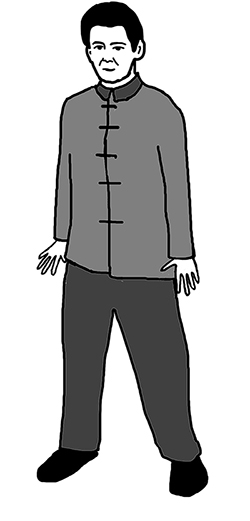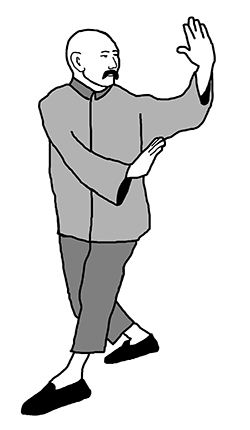
The Journey In
Millions of years of evolution come to fruition in the first year of life when you stand on two feet.
Wuji: The Stance without Movement
In stillness, Wuji stands, the posture that precedes and completes Taijiquan. Before the set begins it appears, a stance whose sole purpose is to be: human and erect. In movement Wuji flows, the unifying essence of Taijiquan. Throughout the set it continues, enduring and constant as changes course through the body. And in stillness again, Wuji remains, the posture that lasts after all intention subsides utterly neutral and utterly present. Despite its seeming simplicity refining Wuji proves to be an evasive and difficult accomplishment.
Why Wuji
It took nature millions of years of refinement to bring us to this uniquely human accomplishment, standing upright. Although by the first couple of years of our lives we've achieved this feat, it turns out that mastery is a long way off. As basic as standing on two feet is to our identity, it is extremely difficult to do correctly. The ten thousand tensions that are evident in our habitual posture inhibit good Taiji. and each and every one of these tensions prevents our body from moving as a singular, connected whole. To practice correct Taiji, the entire body must work as a unified structure, dynamically integrated. In this way, every part can develop a natural spring-like resiliency, a feeling of inflatedness. So important is correct Wuji that even a slight deviation substantially lessens freedom and power.
What at first glance seems so obvious and simple turns out to be excruciatingly difficult. Even if you're not a beginner at Taiji and you know plenty of "movements" from previous studies, there is no point in just adding more "choreography" if it's still a struggle to stand relaxed and erect, unencumbered by tension. What's more, under the close scrutiny of a teacher, you may well discover that every move of your Taiji is in error to one degree or another. All this and more if you do not comprehend and include Wuji throughout your Taiji. While it may be painful to acknowledge that after years of Taiji you retain such a fundamental flaw, it should become clear that this is the most important, single prerequisite to further progress.
How to Wuji
To stand in Wuji correctly, you must be perfectly balanced and upright. Easier said than done. Here are some thoughts to help you to reveal Wuji. Most importantly, be honest with yourself and, if you can, challenge the efficacy of what you discover with a training partner. Research and test everything. Investigate so that what you know comes from your own experience, not just the words of someone else. These skills are not reserved for the few. They may take time and effort (Kung Fu) to develop, but they're not reserved for an elite team. No magic.
On the practical side: Place the feet shoulder width apart; allow the knees to open slightly outward while remaining soft and unlocked; point the toes the same direction as the knees; relax the hip joints; slightly tuck then relax the tail bone; bow the lower back rearward then release elongating the spine and reducing the "S" curve; elongate the spine without tension; lift the head; drop the shoulders; and allow the wrists to engage slightly, so that the hands are neither limp nor tense. Allow the skeletal, muscular and cellular systems to keep the body erect without effort.
On the traditional side: All the admonitions from the Taiji Classics apply: head suspended; shoulders nested; chest sinking; elbows hung and heavy; back straightened and sprung; waist supple and relaxed; yin and yang unified in stillness; no excess and no insufficiency; the breath sunk to the Dantian (lower abdomen); and the whole body light and sensitive, balanced and not leaning. (The further admonitions in the Classics, many of which address the principles of movement, apply but are more readily evident in the moving Taijiquan form.)
On the poetic side: Stand like a sunflower seeking the noonday sun. Remember, relaxation is gravity's purview; the spirit's work is to soar. Allow the tension to fall like sand in an hourglass: dropping straight down. Once you have done all these things pay attention to the whole of your body, giving no special regard to any part.
Coping with Discomfort
One of the best ways to deal with the physical discomfort is to slowly build up the duration of practice. Practice needs to be sustainable over the long haul. In order to overcome the difficulties, faith in the principles and philosophical underpinnings is also necessary. Taijiquan derives from philosophical revelations about the ways of nature. If you don't embrace the ideas at the core, you'll have a difficult time learning anything beyond outward choreography. In part, this is because, the compensatory strengths of the muscular system, the strength in the extremities, can overcome the more subtle skills that develop over the long range.
The methodology of removing traumas is likened to water. Water has unique qualities, which relate Taiji in important ways. Among them are the capacity to evaporate, the capacity to expand, to freeze, to suspend, to liquefy, and includes the ability to dissolve solids into solution, to cleanse, to erode, to fill, and the power to destroy. Water is the softest tangible element, displaced by a feather. At the same time, it is the most powerful, wearing away canyons. In each of its three principle states frozen, liquid or gaseous, the water metaphor provides helpful insight into the progressive nature tension release. The transitions take time to thaw, melt and evaporate.
It takes great faith to endure the time and counter-intuitive requirements of Taijiquan. If your ego resists, your muscles will tense and fight back. Even the face can be a storehouse of tension. The struggle with oneself can be overwhelming without patience and trust. It's important to remember also that just as sensations arise, so too, will they subside. The key is not to interfere with this process by muscular manipulations like adjusting your uncomfortable shoulders or wiggling your hips. Trying to release tension this way will only serve to compound it. Relaxation is a continual process of letting go. Focusing on this principle will help you endure any discomfort.
Staying on Track
How does one assure oneself of correct practice, that one is not deviating off course? Whenever possible, work with a competent instructor. In the absence of a qualified teacher, practice with a training partner who can test the efficacy of your Wuji stance by applying light, sustained pressure from different directions. As the pressure mounts, relax. One will be able to observe more easily many localized tensions. However, here's a word of caution to keep in mind while testing stances. It is important to use only enough pressure to challenge your ability to relax and not to overwhelm your Wuji. Remember, this exercise is an experiment in partnership training, not a competition. When done correctly there are significant benefits for the person applying the pressure. The tester can work on developing greater sensitivity so that his/her hands become like antennae. (In Taijiquan parlance this is called listening skill.) With time and perseverance, the tester will be able to identify the location of the testee's tension. By confirming the observations, both participants will increase their Taijiquan skills.
Wuji is basically the same for beginners and intermediate level students except for length of duration. Care should be taken to ensure quality over quantity. Quantity is best when it is comprised of many sessions of quality. Once one secures a reasonable degree of relaxation, one can practice other standing postures, including any position from the form, more effectively. In time one gains sharper focus, builds greater endurance, and distills a more attuned self-awareness. The greater the degree of relaxation, the greater the benefits. Wuji practice leads to better overall vitality and better ability to control the body and energy.




